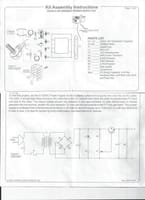FAQ
TL;DR: For quiet audio, replace the pass transistor with an LM317L or add ~3300 µF from Q1 base to ground; this “turns Q1 into a capacitance amplifier.” Statistic: 3300 µF often hits the target at ~50 mA loads. [Elektroda, Steve Lawson, post #21660673]
Why it matters: Cleaner DC reduces 120 Hz hum and garbling in low‑power synthesizer rails.
Quick Facts
- Typical load cited: ~50 mA at 12–15 VDC for the steam‑engine synth; noise appeared on a new kit PSU. [Elektroda, Michael Fleischer, post #21660671]
- Drop‑in fix: LM7812/LM7815 with ≥1000 µF bulk, 0.1 µF HF bypass, and ~470 µF output for low ripple. [Elektroda, Kevin Parmenter, post #21660674]
- Minimal‑rework tweak: 220 µF from pot wiper/base to ground can cut 120 Hz ripple ≈40×. [Elektroda, DAVID CUTHBERT, post #21660679]
- Layout helps: Twist PSU output leads, keep pot leads short, and add 0.1–1 µF from base to ground. [Elektroda, Todd Hayden, post #21660672]
- Lower ESR trick: Use two caps in parallel (e.g., 2×2400 µF) instead of one 4700 µF. [Elektroda, Steve Lawson, post #21660685]
How do I quickly cut the hum without redesigning the supply?
Add a 220 µF capacitor from the pot wiper (transistor base) to the negative rail. Users reported it slashes 120 Hz ripple by about 40× and restored clean audio. Keep leads short and observe polarity. “220 µF will cut the 120 Hz ripple by a factor of 40.” [Elektroda, DAVID CUTHBERT, post #21660679]
What’s the best regulator swap for an audio‑quiet 12–15 V rail?
Use a 7812 or 7815 linear regulator. Provide ≥1000 µF at the rectifier output, 0.1 µF close to the regulator for stability, and ~470 µF on the output. This combination delivers a smooth, low‑noise rail suitable for audio loads around tens of milliamps. [Elektroda, Kevin Parmenter, post #21660674]
Can I keep it variable? What about LM317L?
Yes. Rewire the pot as the LM317L’s adjust divider. Note the output won’t go to 0 V; minimum is about 1.25 V. If you need near‑zero volts, add a negative reference or a different topology. “With the LM317L, it won’t adjust to 0 (more like 1.25 V).” [Elektroda, Steve Lawson, post #21660673]
How big should the extra smoothing capacitor be if I stay with the transistor?
Place a large electrolytic, often around 3300 µF, from the base of Q1 to ground. This forms a capacitance multiplier effect and improves ripple rejection at low current. Steve’s linear estimate targeted 600–3300 µF depending on transistor gain and tolerated ripple. [Elektroda, Steve Lawson, post #21660673]
What wiring and decoupling practices reduce audible noise?
Twist the PSU output pair, route it away from mains and motor wiring, keep potentiometer leads short, and add a 0.1–1 µF cap from the transistor base to ground. These steps lower pickup and stabilize control impedance. [Elektroda, Todd Hayden, post #21660672]
Is my noisy wall‑wart or generator the culprit?
Unregulated adapters and aging generators often have high ripple and spikes. A regulated DC source or a retrofit regulator can eliminate garbling. Consider a regulated supply before chasing synthesizer faults. [Elektroda, Kevin Parmenter, post #21660674]
Does doubling a 4700 µF output capacitor reduce ripple?
Yes. Ripple scales with 1/C, so increasing capacitance reduces ΔV. It does not raise output voltage. Watch ESR and loop stability when changing values. “dV = i·dt/C,” so larger C means less ripple for the same current. [Elektroda, Todd Hayden, post #21660684]
How can I lower ESR without oversized capacitors?
Place two electrolytics in parallel, such as 2×2400 µF instead of one 4700 µF. Parallel ESR combines like resistors, decreasing effective ESR and ripple. This trick maintains value and improves dynamic performance. [Elektroda, Steve Lawson, post #21660685]
What’s a capacitance multiplier, in simple terms?
Feeding the base of a pass transistor from a large, smoothed node makes the emitter see an effectively much larger capacitance. It multiplies smoothing by the transistor’s current gain, improving ripple rejection for small loads. [Elektroda, Steve Lawson, post #21660673]
Any fast 3‑step How‑To for the 7812/7815 retrofit?
- Add ≥1000 µF after the rectifier; wire IN to the regulator.
- Tie GND to supply ground; place a 0.1 µF ceramic at OUT‑to‑GND near the regulator.
- Add ~470 µF from OUT‑to‑GND; verify 12 V or 15 V under load. [Elektroda, Kevin Parmenter, post #21660674]
What minimum load and current should I expect in this synth scenario?
The referenced steam‑engine synthesizer draws about 50 mA at 12–15 VDC. That low current favors simple linear regulation or a capacitance multiplier for quiet operation. Ensure headroom for line sag and startup. [Elektroda, Michael Fleischer, post #21660671]
What ripple period should I design around on 60 Hz mains?
Full‑wave rectification yields 120 Hz ripple. In the thread’s sizing math, a time slice of about 6 ms was used for estimates when picking base capacitors. Design filters around that interval. [Elektroda, Steve Lawson, post #21660673]
Can overvoltage destroy my synth? How do I add protection?
Yes. Add simple overvoltage crowbar protection to short the rail if it rises dangerously, tripping a fuse. Designers often pair crowbars with adjustable regulators in variable supplies. See the MC3423 approach linked. [Elektroda, Mark Harrington, post #21660681]
Will twisting wires and moving them actually make an audible difference?
Yes. Twisting the supply pair reduces loop area and cancels magnetic pickup from nearby power wiring or motors. Short, tidy pot leads also reduce injected noise. Add a small 0.1–1 µF base bypass if needed. [Elektroda, Todd Hayden, post #21660672]
Any edge cases I should know before choosing LM317L?
LM317L cannot output below about 1.25 V, so it won’t work for 0 V testing. Plan for that limit or use a different regulator architecture if you need true 0–12 V adjustment. [Elektroda, Steve Lawson, post #21660673]



